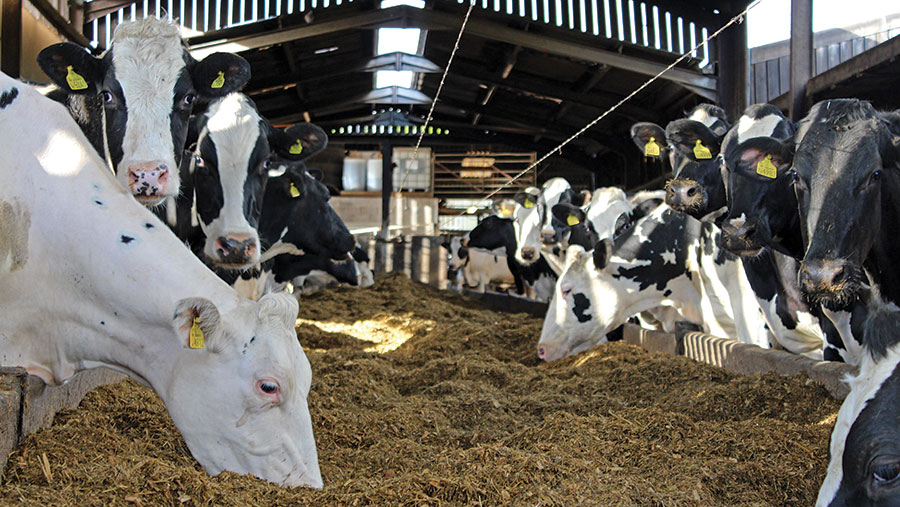How protein feed during transition can up dairy yields
 Submitted photo DO NOT REUSE
Submitted photo DO NOT REUSE Placing as much emphasis on protein feeding as controlled energy feeding in the dry cow period could help farmers maximise yields and milk proteins in lactation, according to one nutrition expert.
Dr Chris Bartram, head of nutrition for Mole Valley Feed Solutions, believes protein has been the “forgotten element” of transition cow feeding for too long, leaving cows open to “negative protein balance” and potentially holding back performance in early lactation.
“For a long time we have majored on the energy aspect of feeding, but now I think we need to shift our attention to protein, along with the accepted approach to controlled energy feeding,” says Dr Bartram.
See also: Expert advice for feeding dry cows
For some time, feeding controlled energy diets to dry cows has been recognised as the best way to minimise the natural drop in dry matter intakes at calving and maximise health and performance post-calving.
However, Dr Bartram believes this has often come at the detriment of protein.
“Straw is commonly used as a way to reduce ration energy content, but straw is naturally low in protein so there is a danger that cow protein requirements are not being met,” he says.
To fulfill a cow’s protein needs in the three weeks before calving, a transition diet needs to deliver an average 1,275g of metabolisable protein.
However Dr Bartram estimates many transition diets could be underfeeding metabolisable protein by as much as 20%.
“There is a real danger, not only that the rumen bacteria are being starved of protein, but also that the supply of digestible undegradable protein (DUP) is below optimum,” he says.
“This means the cow is in ‘negative protein balance’ during the period around calving.
However, feeding higher levels of metabolisable protein before calving will result in a reduction in the mobilisation of body protein reserves around calving.”
Increased protein levels help drive milk yield and protein content, he adds.

Graeme Cock
Case study: Graeme and Patrick Cock, Newton Abbot, Devon
Devon farmers Graeme and Patrick Cock have turned their attention to protein feeding in the transition period as been part of an overall drive to maximise performance in the 650-cow herd at Younghouse Farm, Ashburton, Newton Abbot, Devon.
The Holstein Hemsington herd yields 12,100 litres a cow a year and milk is sold to Arla, which means milk constituents are becoming increasingly important.
“We need to get the best value from our milk contract by getting as much milk as possible and maximising fat and protein, while maintaining health and making gains on efficiencies,” Graeme Cock explains.
See also: Improved dry cow condition boosts fertility and yields
Methionine
- Two types of methionine (Methionine 1 and Methionine 2) fed 21 days before calving to 30 days in milk.
- Methionine supplementation increased milk yield 3.4kg/day.
- DM intake was higher (1.9kg) for methionine supplemented cows in early lactation.
- Blood neutrophil phagocytosis at 21 days was greater with methionine supplementation (suggests better immune function).
- Feeding methionine resulted in a tendency for a lower incidence of ketosis post-partum.
Cows are dry for seven to eight weeks and calve for 10 months of the year with the busiest period from June to August to allow outside calving.
Changes in transition cow protein feeding have played a significant part in increasing milk proteins and yields.
Dr Bartram, who handles the farm’s nutrition, explains the main diet alterations have involved the introduction of a high protein, specialist compound feed, which provides a convenient way to feed different protein sources.
“Before we made changes, the transition ration averaged 950g of metabolisable protein a cow a day.
“We then increased this to meet the required 1,275g using a product including a range of proteins of differing degradability including soya, rape, protected soya, prairie meal and urea,” he says.
This is fed in combination with maize, baled grass silage, chopped straw, minerals, magnesium chloride and part of the early lactation mix.
This delivers an metabolisable energy (ME) of 135MJ/day and 14% protein as part of a partial dietary cation-anion balance ration.
Using July calvers as an indicator of improvements, September milk recording data shows a 25% increase in protein yield over three years following changes in feeding (see table 1, below).
In recent months, the amino acids protected methionine and lysine have also been incorporated into the diet.
This follows on from research which shows supplementing with methionine can increase milk yield by 3.4kg/day (see table 2, below).
The herd is also forecast to produce 12,200 litres a cow at 3.90% fat and 3.20% protein by the end of the year.
This is a 20% uplift compared to 2011 when the herd averaged 10,650 litres at 3.76% fat and 3.08% protein.
These improvements will ultimately help the unit achieve the challenging target of producing more than 1t of fat and protein a cow a year.
Table 1: Milk protein and yield improvements in July calvers since increasing metabolisable protein in transition diets |
||
|
2012 |
2015 |
|
|
Milk yield (kg/day) |
42.9 |
52.6 |
|
Protein (%) |
2.88 |
2.93 |
|
Protein yield (g/day) |
1,236 |
1,541 |
Table 2: Effect of feeding amino acids (methionine) 21 days before calving to 30 days in milk |
||||||
|
Control |
Methionine 1 |
Methionine 2 |
||||
|
Milk yield (kg/d) |
35.7 |
38.1 |
40.0 |
|||
|
Milk fat (%) |
4.27 |
4.68 |
4.09 |
|||
|
Milk protein (%) |
3.04 |
3.26 |
3.19 |
|||
|
Source: Osorio, 2013 (Journal of Dairy Science) |
||||||
